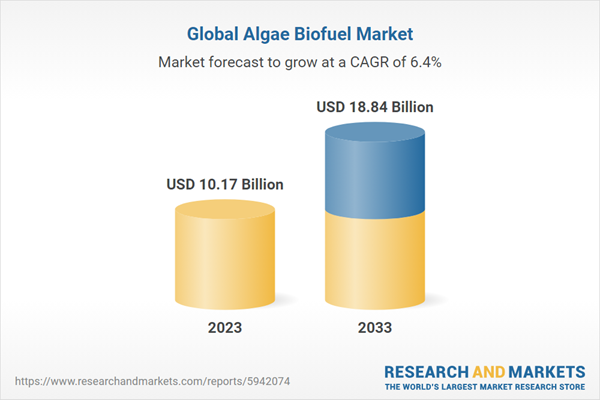Global Algae Biofuel Industry Research 2024: An $18.84 Billion Market by 2033 Featuring Prominent Players – Algenol Biofuels, AlgaEnergy, Viridos, Cellana, and Euglena
Global Algae Biofuel Industry Research 2024: An $18.84 Billion Market by 2033 Featuring Prominent Players - Algenol ... GlobeNewswire


Global Algae Biofuel Market: Focus on Application, Product, and Region – Analysis and Forecast, 2023-2033
Dublin, April 03, 2024 (GLOBE NEWSWIRE) — The “Global Algae Biofuel Market: Focus on Application, Product, and Region – Analysis and Forecast, 2023-2033” report has been added to ResearchAndMarkets.com’s offering.
Introduction
In 2022, the global algae biofuel market reached a valuation of $9,633.7 million. Over the forecast period 2023-2033, the market is projected to exhibit a CAGR of 6.36%, ultimately reaching a value of $18,844.7 million by 2033.
Sustainable Development Goals (SDGs)
The global algae biofuel market has experienced remarkable growth, with North America taking the lead in adopting and advancing this technology. The global shift toward sustainability is a key driver in the global algae biofuel market, driving both innovation and investment in this renewable energy sector. This transformation is motivated by the urgent need to address climate change, reduce reliance on fossil fuels, and create more sustainable energy solutions.

Government Support and Policies
Governments worldwide are implementing policies and incentives to promote renewable energy, including biofuels. The European Union’s Renewable Energy Directive (RED), which sets ambitious targets for renewable energy usage, exemplifies such support. These policies enhance the market viability of algae biofuels by providing financial incentives, tax breaks, and research grants. For instance, the U.S. Department of Energy’s Bioenergy Technologies Office has allocated substantial funds toward algae biofuel research, aiming to make it cost-competitive with conventional fuels.
North America Leading the Market
North America led the global algae biofuel market in 2022, owing to several key factors that propelled the region to the forefront of this burgeoning industry. The robust growth of the global algae biofuel market in North America is primarily attributed to the region’s concerted efforts toward sustainable energy solutions and environmental conservation.
Government initiatives and supportive policies, such as research funding and tax incentives, have fostered a conducive environment for algae biofuel development. Additionally, North America boasts a robust infrastructure for research and development, facilitating technological advancements and innovations in algae cultivation and biofuel production. The region’s awareness and commitment to reducing carbon emissions, coupled with a growing emphasis on achieving energy independence, have driven increased investments in algae biofuel projects.
Industrial Impacts
The algae biofuel market is marked by a competitive landscape, with key players such as Algenol Biofuels, Inc., Viridos, Inc., Cellana Inc., Genifuel Corporation, Neste, and Algae Systems, LLC. leading the industry. In 2022, these companies collectively held approximately 35% of the market share.
The market exhibits both competitive and fragmented characteristics, as several players contribute to the diverse ecosystem of algae biofuel solutions. Algenol Biofuels, Inc., with its advanced algae biofuel technologies, and Cellana Inc., specializing in multispectral sensors, are prominent players, along with Viridos, Inc., Genifuel Corporation, AlgaEnergy S.A., collectively shaping the evolving landscape of algae biofuel technologies.
Viridos Inc., Origin Oils Inc., and Algae Systems, LLC. are some of the emerging companies that have remained in the limelight for the last few years in the global algae biofuel market. Some of the strategies adopted by algae biofuel producers are new product launches, business expansions, and mergers and acquisitions. Apart from market development, sealing new partnerships and collaborations are the other strategies being implemented.
Transportation Industry Dominating the Market
In 2022, the global algae biofuel market was predominantly led by the transportation industry due to a confluence of factors that underscored the sector’s commitment to sustainable and eco-friendly fuel alternatives.
Across aviation and automotive domains, algae biofuels gained prominence as a pragmatic solution to address both ecological concerns and regulatory imperatives for curbing carbon emissions. Algae biofuels, with their high energy density and compatibility with existing infrastructure, became an attractive choice for fueling various modes of transportation.
The collaborations between algae biofuel producers and key players in the transportation sector, along with supportive policies and incentives, facilitated the integration of algae biofuels into the broader fuel supply chain.
Biodiesel Type Dominating the Market
In 2022, biodiesel emerged as the leading type in the global algae biofuel market, owing to a combination of factors that solidified its position as a key product type in the renewable energy landscape.
The prominence of biodiesel within the algae biofuel sector can be attributed to its compatibility with existing diesel engines and infrastructure, making it a seamless and cost-effective transition for industries and consumers. The heightened demand for cleaner and sustainable alternatives in the transportation and industrial sectors drove the popularity of biodiesel derived from algae.
Chemical Process Dominating the Market
In 2022, the chemical process emerged as the leading algae biofuel manufacturing process in the global algae biofuel market, owing to a myriad of factors that underscore its prominence in the renewable energy sector. The chemical process involves the conversion of algae biomass into biofuels through methods such as pyrolysis, hydrothermal liquefaction, and catalytic cracking.
This manufacturing approach gained traction due to its scalability, efficiency, and versatility in processing various types of algae. The chemical process allows for the extraction of lipids and carbohydrates from algae biomass, which are then converted into biodiesel and other
SDGs, Targets, and Indicators
1. Which SDGs are addressed or connected to the issues highlighted in the article?
- SDG 7: Affordable and Clean Energy
- SDG 9: Industry, Innovation, and Infrastructure
- SDG 13: Climate Action
- SDG 17: Partnerships for the Goals
The article discusses the global shift towards sustainability, the need to address climate change, and the reduction of reliance on fossil fuels. These issues align with SDG 7, which aims to ensure access to affordable, reliable, sustainable, and modern energy for all. The article also mentions government initiatives, research funding, and collaborations, which are relevant to SDG 17, which focuses on partnerships for the goals. Additionally, the advancements in algae biofuel technologies and the integration of algae biofuels into the transportation industry contribute to SDG 9, which promotes sustainable industrialization and innovation. Lastly, the emphasis on reducing carbon emissions aligns with SDG 13, which aims to take urgent action to combat climate change.
2. What specific targets under those SDGs can be identified based on the article’s content?
- SDG 7.2: Increase substantially the share of renewable energy in the global energy mix.
- SDG 9.4: Upgrade infrastructure and retrofit industries to make them sustainable.
- SDG 13.2: Integrate climate change measures into national policies, strategies, and planning.
- SDG 17.16: Enhance the global partnership for sustainable development.
The targets mentioned in the article include increasing the adoption and advancement of algae biofuel technologies (related to SDG 7.2), fostering a conducive environment for algae biofuel development through government initiatives and supportive policies (related to SDG 9.4), addressing climate change through the reduction of carbon emissions (related to SDG 13.2), and promoting partnerships and collaborations in the biofuel industry (related to SDG 17.16).
3. Are there any indicators mentioned or implied in the article that can be used to measure progress towards the identified targets?
Yes, the following indicators can be used to measure progress towards the identified targets:
- Market valuation and growth rate of the global algae biofuel market
- Investment in algae biofuel research and development
- Government policies, incentives, and financial support for renewable energy
- Reduction in reliance on fossil fuels
- Reduction in carbon emissions from the transportation industry
- Number of partnerships and collaborations in the biofuel industry
These indicators can be used to assess the progress made in increasing the share of renewable energy, upgrading infrastructure, integrating climate change measures, and enhancing global partnerships for sustainable development.
SDGs, Targets, and Indicators Table
| SDGs | Targets | Indicators |
|---|---|---|
| SDG 7: Affordable and Clean Energy | Increase substantially the share of renewable energy in the global energy mix. | – Market valuation and growth rate of the global algae biofuel market – Investment in algae biofuel research and development – Government policies, incentives, and financial support for renewable energy |
| SDG 9: Industry, Innovation, and Infrastructure | Upgrade infrastructure and retrofit industries to make them sustainable. | – Market valuation and growth rate of the global algae biofuel market – Investment in algae biofuel research and development – Reduction in reliance on fossil fuels |
| SDG 13: Climate Action | Integrate climate change measures into national policies, strategies, and planning. | – Reduction in carbon emissions from the transportation industry – Government policies, incentives, and financial support for renewable energy |
| SDG 17: Partnerships for the Goals | Enhance the global partnership for sustainable development. | – Number of partnerships and collaborations in the biofuel industry – Investment in algae biofuel research and development |
Behold! This splendid article springs forth from the wellspring of knowledge, shaped by a wondrous proprietary AI technology that delved into a vast ocean of data, illuminating the path towards the Sustainable Development Goals. Remember that all rights are reserved by SDG Investors LLC, empowering us to champion progress together.
Source: globenewswire.com

Join us, as fellow seekers of change, on a transformative journey at https://sdgtalks.ai/welcome, where you can become a member and actively contribute to shaping a brighter future.







